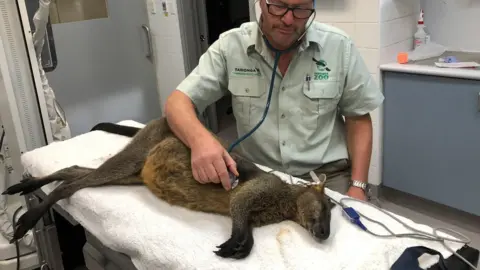Wallaby captured after hopping across Sydney Harbour Bridge
The unusual sight of a wallaby bounding across the Sydney Harbour Bridge has surprised early-morning motorists.
Drivers spotted the "wayward" marsupial on the iconic bridge just before 05:00 local time on Tuesday (18:00 Monday GMT), police said.
Authorities monitored the wallaby as it crossed lanes, traversed the 1,150m-long (3,700ft) landmark and turned on to an expressway in the city centre.
Police eventually caught up with it near a music school.
The animal appeared startled and was taken to a nearby zoo for assessment by vets, police said.
 Getty Images
Getty Images NSW POLICE
NSW POLICEOne witness told Sydney radio station 2GB she could not believe what she had seen.
"I thought, no, no way do you see a kangaroo in the city like that. I've only seen them in the country," said the woman, identified only as Michelle.
"I just thought of people's safety and the safety of the little kangaroo or wallaby."
You might also like:
Police said the 13kg (29lb) swamp wallaby, also known as the black wallaby, may have come from a golf course about 3km (1.8 miles) from the bridge.
The Sydney Harbour Bridge connects major roads and city buildings on both ends, making the wallaby's trip feel incongruous to locals. Some enjoyed fun on social media.
Allow Twitter content?
Allow Twitter content?
It also prompted mirth in local media, with Sydney's Daily Telegraph writing: "Nothing is more Aussie than this story."
Taronga Zoo said vets assessed the wallaby, an adult male, and found no significant injuries.
The zoo's Australian fauna expert, Nick de Vos, said the species was common in parts of Sydney - especially bushland - but "in an urban landscape like the city, it's a bit of a shock - it's definitely more rare".
 TARONGA ZOO
TARONGA ZOOHe told the BBC that the wallaby's path to the bridge was unclear - possibly, it had been in parks around the harbour.
"There's also any chance it was just near the bridge and got spooked, and hopped very quickly to the bridge and found itself in a one-way path not knowing where else to go," Mr de Vos said.
The animal will be monitored at the zoo for up to 48 hours before being returned to the wild.
